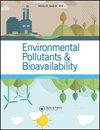天然土壤纳米颗粒在饱和多孔介质中的迁移:pH和离子强度的影响
Q3 Chemical Engineering
引用次数: 13
摘要
摘要为了解离子强度和pH对天然土壤纳米颗粒(NS)在饱和多孔介质中运移的影响,采用不同pH和离子强度的溶液对风沙土纳米颗粒(AS)、人工黄土土纳米颗粒(CS)、人工黄土土纳米颗粒(MS)和红壤纳米颗粒(RS)进行浸出。土壤纳米颗粒的回收率依次为AS > RS > MS > CS。随着pH值的增加和离子强度的降低,土壤纳米颗粒的迁移增强,这与NS的Zeta电位的变化有关。土壤纳米粒子的组成和表面电荷对NS的沉积也有影响。柱试验表明,土壤纳米颗粒与饱和石英砂的相互作用主要是由土壤纳米颗粒的物理化学性质决定的。ph值和离子强度对NS与砂的Derjaguin-Landau-Verwey-Overbeek相互作用能有影响。采用一维平流-分散-反应方程可以准确模拟土壤纳米颗粒在饱和多孔介质中的运移过程。本文章由计算机程序翻译,如有差异,请以英文原文为准。
Transport of natural soil nanoparticles in saturated porous media: effects of pH and ionic strength
Abstract To understand the effects of ionic strength and pH on the transport of natural soil nanoparticles (NS) in saturated porous media, aeolian sandy soil nanoparticles (AS), cultivated loessial soil nano particles (CS), manural loessial soil nanoparticles (MS) and red soil nanoparticles (RS) were leached with solutions of varying pH and ionic strength. The recovery rate of soil nanoparticles decreased in the order AS > RS > MS > CS. Transport of soil nanoparticles was enhanced with increasing pH and decreasing ionic strength and was attributable to changes in the Zeta potential of NS. Deposition of NS was also affected by the composition of soil nanoparticles and the surface charge. Column experiments showed that the interaction between soil nanoparticles and saturated quartz sand was mainly due to the physical and chemical properties of soil nanoparticles. The Derjaguin–Landau–Verwey–Overbeek interaction energies between NS and sand were affected by pHs and ionic strengths. Soil nanoparticles transport through saturated porous media could be accurately simulated by the one-dimensional advection-dispersion-reaction equation.
求助全文
通过发布文献求助,成功后即可免费获取论文全文。
去求助
来源期刊
CiteScore
1.62
自引率
0.00%
发文量
0
审稿时长
1 months
期刊介绍:
Chemical Speciation & Bioavailability ( CS&B) is a scholarly, peer-reviewed forum for insights on the chemical aspects of occurrence, distribution, transport, transformation, transfer, fate, and effects of substances in the environment and biota, and their impacts on the uptake of the substances by living organisms. Substances of interests include both beneficial and toxic ones, especially nutrients, heavy metals, persistent organic pollutants, and emerging contaminants, such as engineered nanomaterials, as well as pharmaceuticals and personal-care products as pollutants. It is the aim of this Journal to develop an international community of experienced colleagues to promote the research, discussion, review, and spread of information on chemical speciation and bioavailability, which is a topic of interest to researchers in many disciplines, including environmental, chemical, biological, food, medical, toxicology, and health sciences.
Key themes in the scope of the Journal include, but are not limited to, the following “6Ms”:
Methods for speciation analysis and the evaluation of bioavailability, especially the development, validation, and application of novel methods and techniques.
Media that sustain the processes of release, distribution, transformation, and transfer of chemical speciation; of particular interest are emerging contaminants, such as engineered nanomaterials, pharmaceuticals, and personal-care products.
Mobility of substance species in environment and biota, either spatially or temporally.
Matters that influence the chemical speciation and bioavailability, mainly environmentally relevant conditions.
Mechanisms that govern the transport, transformation, transfer, and fate of chemical speciation in the environment, and the biouptake of substances.
Models for the simulation of chemical speciation and bioavailability, and for the prediction of toxicity.
Chemical Speciation & Bioavailability is a fully open access journal. This means all submitted articles will, if accepted, be available for anyone to read, anywhere, at any time. immediately on publication. There are no charges for submission to this journal.

 求助内容:
求助内容: 应助结果提醒方式:
应助结果提醒方式:


